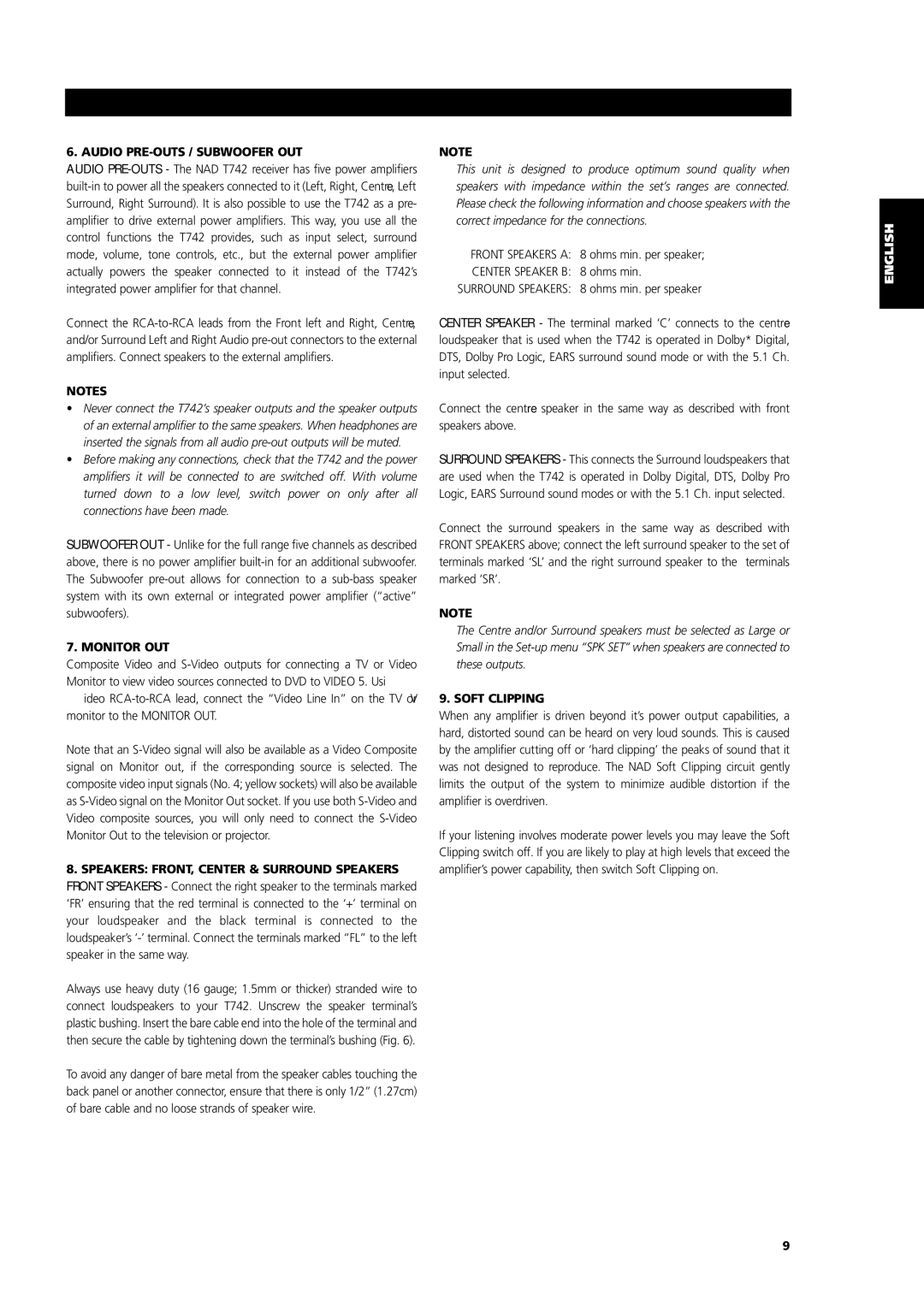
6. AUDIO PRE-OUTS / SUBWOOFER OUT
AUDIO
Connect the
NOTES
•Never connect the T742’s speaker outputs and the speaker outputs of an external amplifier to the same speakers. When headphones are inserted the signals from all audio
•Before making any connections, check that the T742 and the power amplifiers it will be connected to are switched off. With volume turned down to a low level, switch power on only after all connections have been made.
SUBWOOFER OUT - Unlike for the full range five channels as described above, there is no power amplifier
7. MONITOR OUT
Composite Video and
ideo
Note that an
8.SPEAKERS: FRONT, CENTER & SURROUND SPEAKERS FRONT SPEAKERS - Connect the right speaker to the terminals marked ‘FR’ ensuring that the red terminal is connected to the ‘+’ terminal on your loudspeaker and the black terminal is connected to the loudspeaker’s
Always use heavy duty (16 gauge; 1.5mm or thicker) stranded wire to connect loudspeakers to your T742. Unscrew the speaker terminal’s plastic bushing. Insert the bare cable end into the hole of the terminal and then secure the cable by tightening down the terminal’s bushing (Fig. 6).
To avoid any danger of bare metal from the speaker cables touching the back panel or another connector, ensure that there is only 1/2” (1.27cm) of bare cable and no loose strands of speaker wire.
NOTE
This unit is designed to produce optimum sound quality when speakers with impedance within the set’s ranges are connected. Please check the following information and choose speakers with the correct impedance for the connections.
FRONT SPEAKERS A: 8 ohms min. per speaker;
CENTER SPEAKER B: 8 ohms min.
SURROUND SPEAKERS: 8 ohms min. per speaker
CENTER SPEAKER - The terminal marked ‘C’ connects to the centre loudspeaker that is used when the T742 is operated in Dolby* Digital, DTS, Dolby Pro Logic, EARS surround sound mode or with the 5.1 Ch. input selected.
Connect the centre speaker in the same way as described with front speakers above.
SURROUND SPEAKERS - This connects the Surround loudspeakers that are used when the T742 is operated in Dolby Digital, DTS, Dolby Pro Logic, EARS Surround sound modes or with the 5.1 Ch. input selected.
Connect the surround speakers in the same way as described with FRONT SPEAKERS above; connect the left surround speaker to the set of terminals marked ‘SL’ and the right surround speaker to the terminals marked ‘SR’.
NOTE
The Centre and/or Surround speakers must be selected as Large or Small in the
9. SOFT CLIPPING
When any amplifier is driven beyond it’s power output capabilities, a hard, distorted sound can be heard on very loud sounds. This is caused by the amplifier cutting off or ‘hard clipping’ the peaks of sound that it was not designed to reproduce. The NAD Soft Clipping circuit gently limits the output of the system to minimize audible distortion if the amplifier is overdriven.
If your listening involves moderate power levels you may leave the Soft Clipping switch off. If you are likely to play at high levels that exceed the amplifier’s power capability, then switch Soft Clipping on.
SVENSKA PORTUGUÊS ITALIANO ESPAÑOL NEDERLANDS DEUTSCH FRANÇAIS ENGLISH
9
